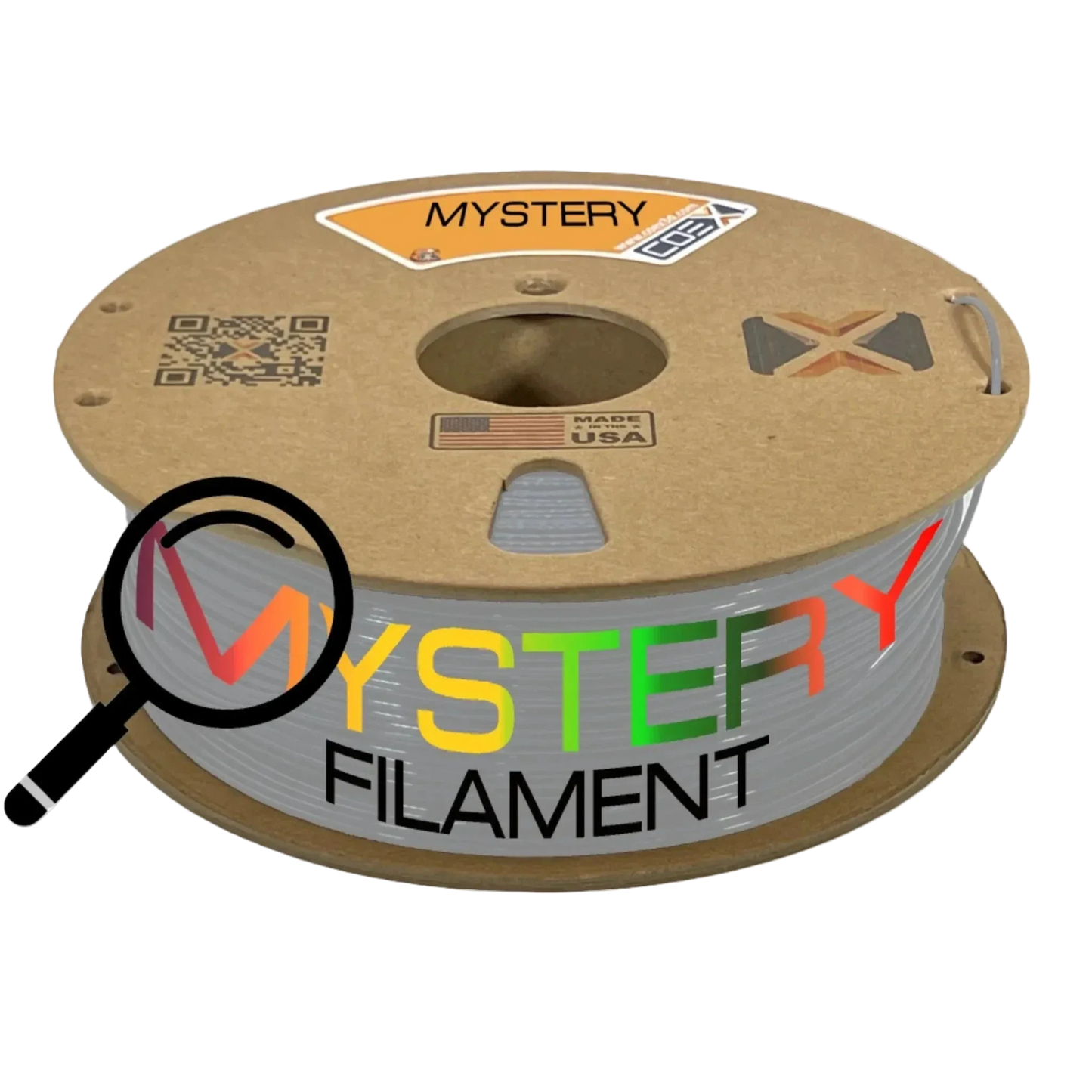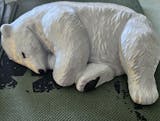
Experience the Magic of Transition “Mystery” Color PLA+Silk
Looking for a unique and eye-catching filament for your 3D printing projects? Look no further than Transition Mystery Color PLA+Silk filament! This high-quality filament is perfect for anyone looking to create vivid and captivating 3D prints that stand out from the crowd. Made from a blend of PLA and silk, this filament is not only beautiful but also incredibly strong and durable. It has the same great features as regular PLA but with the added bonus of a stunning silky finish that catches the light and gives your prints a luxurious sheen. But perhaps the most exciting thing about Transition Mystery Color PLA+Silk filament is the mystery! Each roll contains a unique and unpredictable blend of colors that transition seamlessly throughout your print, creating stunning color gradients that you simply won't find with any other filament. With Transition Mystery Color PLA+Silk, each print is a one-of-a-kind masterpiece. Whether you're a professional 3D artist or a hobbyist, Transition Mystery Color PLA+Silk filament is the perfect addition to your toolkit. It's easy to use with most 3D printers and produces consistent and high-quality results every time. So why wait? Order your roll of Transition Mystery Color PLA+Silk filament today and experience the magic for yourself!
Note: These are not a rainbow filament. The color change in each spool will vary and be very gradual.
Coex 3D PLA+Silk is made with Virgin NatureWorks USA Ingeo resin, a high-quality colorant, and our secretive additive. All of Coex's filament is made in our production facility located in Wisconsin, USA. Coex 3D uses industrial-grade extruders and laser measuring quality control to ensure quality, consistency, and a 1.75±0.03mm diameter specification with every spool. We provide filament that gives excellent-looking and strong prints.
Coex 3D recommends the following print settings when printing with our PLA. Settings will vary depending on your specific printing setup.
- Hotend Temperature: 215 °C - 235 °C
-
Important! This temperature range may seem hotter than you're used to for other PLA+Silk filaments. Using 100% virgin resin causes our PLA+Silk to require slightly higher printing temperatures.
- Heated Bed Temperature: 40 °C - 60 °C
- Note: A heated bed is not a strict requirement when printing PLA+Silk, but using one is recommended.
- Recommended Build Surfaces/Adhesives
- Glass Build Surface
- PEI Build Surface
- Magigoo
- Painter's Tape
- Glue Stick
- Cooling Fan: Recommended. Up to 100% fan speed is advisable when printing PLA+Silk.
- Drying: PLA+Silk filament is hygroscopic and will absorb moisture from the air if not stored in a dry environment. If this happens, you may experience under-extrusion/inconsistent extrusion or excess stringing. You may also hear a "popping" sound coming from the hotend during printing. We recommend drying our PLA at 55 °C for at least 3 hours if it has been exposed to excess humidity.
Technical Printing Guide - COEX PLA
1. Material Notes
- Keep filament dry - store properly and dry before use
- PLA is less hygroscopic than other materials, but proper storage helps maintain quality
- If needed, dry at 55°C for 3 hours or more
- Check for any visible damage before use
2. Temperature Settings
Bed Temperature: 60°C
- Wash the bed often for good adhesion - Use dish soap and rinse thoroughly to remove oils
- Use bed adhesion products if necessary (gluestick, WELD3D)
- Use brim for tall or large prints
- Keep ambient temperature stable
Extruder Temperature: 215-235°C
3. Basic Parameters
PLA (Polylactic Acid) is a biodegradable polymer known for its ease of printing, good surface quality, and dimensional accuracy. Perfect for decorative parts, prototypes, and general printing needs where mechanical properties are not critical.
| Nozzle | Layer Height | Line Width | Volumetric Speed | Temperature |
| 0.4mm | 0.2mm | 0.42mm | 12.0 mm³/s | 220°C |
| 0.6mm | 0.3mm | 0.62mm | 27.0 mm³/s | 225°C |
| 0.8mm | 0.4mm | 0.82mm | 48.0 mm³/s | 230°C |
| 1.0mm | 0.5mm | 1.02mm | 75.0 mm³/s | 235°C |
4. Speed Settings
0.4mm Nozzle (Volumetric Speed: 12.0 mm³/s)
| Line Type | Percentage | Speed |
| External Perimeter | 50% | 71.43 mm/s |
| Internal Perimeters | 75% | 107.14 mm/s |
| Infill | 100% | 142.86 mm/s |
| Top/Bottom | 60% | 85.71 mm/s |
| First Layer | 30% | 42.86 mm/s |
0.6mm Nozzle (Volumetric Speed: 27.0 mm³/s)
| Line Type | Percentage | Speed |
| External Perimeter | 50% | 72.58 mm/s |
| Internal Perimeters | 75% | 108.87 mm/s |
| Infill | 100% | 145.16 mm/s |
| Top/Bottom | 60% | 87.10 mm/s |
| First Layer | 30% | 43.55 mm/s |
0.8mm Nozzle (Volumetric Speed: 48.0 mm³/s)
| Line Type | Percentage | Speed |
| External Perimeter | 50% | 73.17 mm/s |
| Internal Perimeters | 75% | 109.76 mm/s |
| Infill | 100% | 146.34 mm/s |
| Top/Bottom | 60% | 87.80 mm/s |
| First Layer | 30% | 43.90 mm/s |
1.0mm Nozzle (Volumetric Speed: 75.0 mm³/s)
| Line Type | Percentage | Speed |
| External Perimeter | 50% | 73.53 mm/s |
| Internal Perimeters | 75% | 110.29 mm/s |
| Infill | 100% | 147.06 mm/s |
| Top/Bottom | 60% | 88.24 mm/s |
| First Layer | 30% | 44.12 mm/s |
5. Retraction Settings
| Nozzle | Distance | Speed | Z-Hop |
| 0.4mm | 0.5-0.8mm | 45mm/s | 0.2mm |
| 0.6mm | 0.6-1.0mm | 45mm/s | 0.2mm |
| 0.8mm | 0.8-1.2mm | 40mm/s | 0.2mm |
| 1.0mm | 1.0-1.5mm | 35mm/s | 0.2mm |
6. Cooling Settings
Cooling Configuration:
- First Layer: 0% (fan off)
- General Printing: 100% base fan speed
- Bridges and Overhangs: 100% fan speed
- Layers < 15 seconds: 100% fan speed
Critical Considerations:
- PLA requires maximum cooling for best results
- Full fan speed helps with bridging and overhangs
- The first layer needs no cooling for good adhesion
- Small parts need maximum cooling
7. Troubleshooting Guide
| Problem | Solution |
| Poor Layer Adhesion |
1. Increase temperature by 5-10°C 2. Reduce cooling fan speed for first few layers 3. Clean build surface with IPA
|
| Warping |
1. Increase bed temperature to 60°C 2. Add brim (5-10mm) 3. Ensure no drafts in printing area |
| Stringing |
1. Lower temperature by 5°C 2. Increase retraction speed to 45mm/s 3. Adjust retraction distance |
| Under-extrusion |
1. Increase temperature by 5-10°C 2. Clean nozzle or try cold pull 3. Check filament quality |
| Poor Overhangs |
1. Ensure 100% cooling 2. Reduce temperature by 5°C 3. Reduce print speed by 50% |
PLEASE NOTE: These printing parameters are initial recommendations based on our experience. They may need adjustment depending on your specific 3D printer, environmental conditions, and the geometry of the part you are printing. Use these settings as a starting point and fine-tune them according to your specific needs.



